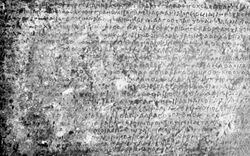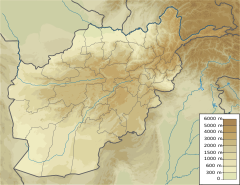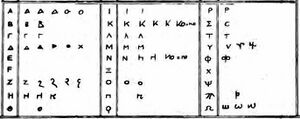نقش رباطك
| نقش رباطك Rabatak Inscription | |
|---|---|
 نقش رباطك | |
| الفترة/الثقافة | القرن الثاني الميلادي |
| أُكتشفت | 36°08′58″N 68°24′15″E / 36.149434°N 68.404101°E |
| الموقع الحالي | متحف كابول، كابول، أفغانستان |
نقش رباطك Rabatak Inscription هو حجر منقوش عليه نص مكتوب باللغة الباخترية بالكتابة اليونانية، عُثِر عليها في 1993 في رباطك، بالقرب من سرخ كوتل في أفغانستان. النقش يتعلق بحكم إمبراطور الكوشان كانيشكا، ويعطي أدلة هامة في أنساب أسرة كوشان. ويعود إلى القرن الثاني الميلادي.
الاكتشاف
عـُثِر على نقش رباطك بالقرب من قمة ربوة اصطناعية، وهي موقع كوشاني، بالقرب من الطريق السريق كابول-مزار شريف، غلى الجنوب الشرقي من ممر رباط الذي يشكل حالياً الحدود بين ولايتي بغلان وسمنگان. وقد عثر عليه بعض المجاهدين الأفغان الذين كانوا يحفرون خندقاً في قمة الموقع، وعثروا معه على عناصر منحوتات صخرية أخرى، مثل مخالب أسد حجري عملاق، تختفى منذ ذلك الحين.
An English aid worker who belonged to the demining organization HALO Trust, witnessed and took a photograph of the inscription before reporting the discovery. The photograph was sent to the British Museum, where its significance as an official document that named four kings of Kushan, was recognised by Joe Cribb. He determined that it was similar to an inscription found in the 1950s at Surkh Kotal by the French Archaeological Delegation in Afghanistan. Cribb shared the photograph with one of only a handful of living people able to read the Bactrian language, Nicholas Sims-Williams of the School of Oriental and African Studies (SOAS). More photographs arrived from HALO Trust workers, and a first translation was published by Cribb and Sims-Williams in 1996.
[….]νο
[….]no
βωγο
bōgo
στοργο
storgo
κανηþκε
kanēške
κοþανο
košan
ραþτογο
raštog
λαδειγo
lādeigo
χοαζαοαργο
xoazaoargo
βαγ[η]-
bag[ē]-
. . . of the great salvation, Kanishka the Kushan, the righteous, the just, the autocrat, the god
ζνογο
znogo
κιδι
kidi
ασo
aso
νανα
Nana
oδo
odo
ασo
aso
oισπoανo
oispoan
µι
mi
βαγανo
bagano
ι
i
þαoδανo
šaodano
αβoρδo
abordo
κιδι
kidi
ιωγo
iōg
χþoνo
xšono
worthy of worship, who has obtained the kingship from Nana and from all the gods, who has inaugurated the year one
νoβαστo
nobasto
σ(α)γωνδι
s(a)gōndi
βαγανo
bagano
σινδαδo
sindado
oτηια
otēia
ι
i
ιωναγγo
iōnaggo
oασo
oaso
oζoαστo
ozoasto
ταδηια
tadēia
αριαo
ariao
ωσ-
ōs-
as the gods pleased. And he *issued a Greek *edict (and) then he put it into Aryan.
ταδo
tado
αβo
abo
ιωγo
iōg
χþoν(o)
xšon(o)
αβo
abo
[ι]
[i]
ιυνδo
iundo
φρoαγδαζo
froagdazo
αβo
abo
þατριαγγε
šatriagge
þαoρε
šaore
αγιτα
agita
κoo-
koo-
In the year one it has been proclaimed unto India, unto the *whole of the realm of the *kshatriyas, that (as for)
αδηανo
adēano
oδo
odo
ι
i
oα(σ)πo
oa(s)po
oδ(o)
od(o)
[ι
[i
ζ]αγηδo
z]agēdo
oδo
odo
ι
i
κωζ(αµ)βo
kōz(am)bo
oδo
odo
ι
i
παλαβoτρo
palabotro
oιδρα
oidra
αδα
ada
αβo
abo
ι
i
ζιριτ-
zirit-
them – both the (city of) . . . and the (city of) Saketa, and the (city of) Kausambi, and the (city of) Pataliputra, as far as the (city of) Sri-Campa
αµβo
ambo
σιδηιανo
sidēiano
πρoβαo
probao
oδo
odo
µανδαρσι
mandarsi
ζαopανo
zaorano
αβo
abo
ι
i
σινδo
sindo
ωσταδo
ōstado
oτη(ι)α
otē(i)a
αρoυγo
arougo
– whatever rulers and other *important persons (they might have) he had submitted to (his) will, and he had submitted all
ιυνδo
iundo
(αβo)
(abo)
ι
i
σινδo
sindo
ωσταδo
ōstado
ταδι
tadi
þαι
šai
κανηþκε
kanēške
αβo
abo
þαφαρo
šafaro
καραλραγγo
karalraggo
φρoµαδo
fromado
India to (his) will. Then King Kanishka gave orders to Shafar the Karalrang[Note 1]
(α)βειναo
(a)beinao
βαγoλαγγo
bagolango
κιρδι
kirdi
σιδι
sidi
β…αβo
b…abo
ριζδι
rizdi
αβo
abo
µα
ma
καδγε
kadge
ραγα
b-
φαρειµoανo
β-
*at this . . . to make the sanctuary which is called B . . . ab, in the *plain of Ka . . ., for these Mismatch in the number of words between lines: 12 word(s) in line 1, 10 word(s) in line 2 (help);
(α)γα(ν)o
(a)ga(n)o
κιδι
kidi
µαρo
maro
κιρδαν(ε)
kirdan(e)
ι
i
µα..o[φ]αρρo
ma…o[f]arro
oµµα
omma
ooηλδι
ooēldi
ια
ia
αµσα
amsa
νανα
nana
oδo
odo
ια
ia
αµ-
am-
gods, (of) whom the . . . *glorious Umma leads the *service here, (namely:) the *lady Nana and the
σα
sa
oµµα
omma
αoρoµoζδo
aoromozdo
µoζδoo(α)νo
mozdoo(a)no
σρoþαρδo
srošardo
ναρασαo
narasao
µιιρo
miiro
oτηια
otēia
oυδoα-
oudoa-
lady Umma, Aurmuzd, the gracious one, Sroshard, Narasa, (and) Mihr. [interlinear text: . . . and he is called Maaseno, and he is called Bizago] And he likewise
νo
no
πι(δo)γιρβo
pi(do)girbo
φρoµαδo
fromado
κιρδι
kirdi
ειµoανo
eimoano
βαγανo
bagano
κιδι
kidi
µασκα
maska
νιβιχτιγενδι
nibixtigendi
oτ-
ot-
gave orders to make images of these gods who are written above, and
ηια
ēia
φρoµαδo
fromado
αβειµoανo
abeimoano
þαoνανo
šaonano
κιρδι
kirdi
αβo
abo
κoζoυλo
kozoulo
καδφισo
kadfiso
þαo
šao
αβo
abo
ι
i
φρ-
fr-
he gave orders to make (them) for these kings: for King Kujula Kadphises (his) great
oνιαγo
oniago
(o)δo
(o)do
α(βo
a(bo
o)oηµo
o)oēmo
(τ)ακτoo
(t)akto
þαo
šao
α(β)[o]
a(b)[o]
ι
i
νια(γ)o
nia(g)o
oδo
odo
αβo
abo
ooηµo
ooēmo
καδφισo
kadfiso
þαo
šao
αβo
abo
grandfather, and for King Vima Taktu, (his) grandfather, and for King Vima Kadphises
(ι)
(i)
πιδα
pido
oδo
odo
αβo
abo
ι
i
χoβιε
xobie
αβo
abo
κανηþκo
kanēško
þαo
šao
tα
ta
σαγωνδι
sagōndi
þαoνανo
šaonano
þαo
šao
ι
i
βαγoπoo-
bagopoo-
(his) father, and *also for himself, King Kanishka. Then, as the king of kings, the Devaputra[Note 2]
ρακ[α]νε
rak[a]ne
[…]
[…]
φρ(o)µαδo
fr(o)mado
κιρδι
kirdi
ταδι
tadi
þαφαρε
šafare
καραλραγγε
karalraggo
κιρδo
kirdo
ειo
eio
βαγoλαγγo
bagolaggo
. . . had given orders to do, Shafar the Karalrang made this sanctuary.
[ ]o
καραλραγγo
karalraggo
oδo
odo
þαφαρo
šafaro
καραλραγγo
karalraggo
oδo
odo
νoκoνζoκo
nokonzoko
ι
i
αþτoo-
aštoo-
[Then . . .] the Karalrang, and Shafar the Karalrang, and Nukunzuk [led] the worship
α[λγo
a[lgo
κιρ]δo
kir]do
ια
ia
φρoµανo
fromano
ειµιδβα
eimidba
βαγε
bage
κιδι
kidi
µαρo
maro
νιβιχτιγενδι
nibixtigendi
ταδανo
tadano
αβo
abo
þαoν-
šaon-
[according to] the (king's) command. (As for) *these gods who are written here – may they [keep] the
αν(o)
an(o)
þαo
šao
αβo
abo
κανηþκε
kanēške
κoþανo
košano
αβo
abo
ιαoηδανι
iaoēdani
ζoρριγι
zorrigi
λρoυ(γ)o
lrou(g)o
αγγαδ…γo
aggad…go
oανινδ-
oanind-
king of kings, Kanishka the Kushan, for ever healthy, *secure, (and) victorious.
o
o
π[…]ι(ν)δι
p[…]i(n)di
oδ[…](δ)ι
od[..](d)i
βα(γ)επooρo
ba(g)epooro
ασo
aso
ιωγo
iōgo
χþoνo
xšono
αβo
abo
ιo
io
(α)
(a)
χþoνo
xšono
ιυνδo
iundo
αρoυγo
arougo
ν-
n-
And [when] the devaputra, the *ruler of all India from the year one to the year *one *thousand,
αρα[
ara[
]ι
]i
β(α)γoλαγγo
b(a)golaggo
αβo
abo
ιωγo
iōgo
χþoνo
xšono
ασπαδo
aspado
ταδι
tadi
αβo
abo
ι
i
αρηµεσo
arēmeso
χþoνo
xšono
αγγαρ[…]
aggar[…]
had *founded the sanctuary in the year one, then *also to the . . . year. . .
[]χα[
[]xa[
π]ιδo
p]ido
þαo
šao
φρoµανα
fromana
αβισσι
abissi
παρηνα
parēna
λαδo
lado
αβισσι
abissi
ρηδγε
rēdge
λαδo
lado
αβισσ[ι..]
abiss[i..]
according to the king's command . . . (and) it was given also to the . . ., (and) it was given also to the . . ., (and) also to
[
[
]þαι
]šai
µαδ...α
mad…a
(α)βo
(a)bo
βαγανo
bagano
λαδo
lado
oδo
ado
φαρειµoανo
fareimoano
αχoδανo
axodano
[σι]δι
[si]di
[α]βo
abo
µι
mi
βαγε
bage
λ[αδo]
l[ado]
. . . the king gave an *endowment to the gods, and . . .
[
[
]ατιδ(η)oσ[
]atid(ē)os
Because of the civil war in Afghanistan years passed before further examination was possible. In April 2000 Jonathan Lee, an English specialist in Afghan history, travelled with Robert Kluijver, director of the Society for the Preservation of Afghanistan's Cultural Heritage, from Mazar-i Sharif to Pul-i Khumri, the provincial capital of Baghlan, to locate the stone. It was eventually found in a storehouse at the Department of Mines and Industry. Lee took photographs that allowed Sims-Williams to publish a more accurate translation, and another translation once Sims-Williams had examined the stone in person (2008).
In July 2000 Robert Kluijver travelled with a delegation of the Kabul Museum to Pul-i Khumri to retrieve the stone inscription (weighing between 500 و 600 كيلوغرام [1،100 و 1،300 lb]). It was brought by car to Mazar-i Sharif and flown from there to Kabul. At the time the Taliban had a favorable policy towards the preservation of Afghan cultural heritage, including pre-Islamic heritage. The inscription, whose historical value had meanwhile been determined by Sims-Williams, became the centrepiece of the exhibition of the (few) remaining artifacts in the Kabul Museum, leading to a short-lived inauguration of the museum on 17 August 2000. Senior Taliban officials objected to the display of pre-Islamic heritage, which led to the closing of the museum (and the transfer of the Rabatak inscription to safety), a reversal of the cultural heritage policy and eventually leading to the destruction of the Buddhas of Bamyan and other pre-Islamic statuary (from February 2001 onwards).
Today the Rabatak inscription is again on display in the reopened Afghan National Museum, or Kabul Museum.
The Rabatak site, again visited by Robert Kluijver in March 2002, has been looted and destroyed (the looting was performed with bulldozers), reportedly by the local commander at Rabatak.
اللقى الرئيسية
الدين
The first lines of the inscription describe Kanishka as:
- "the great salvation, the righteous, just autocrat, worthy of divine worship, who has obtained the kingship from Nana and from all the gods, who has inaugurated the year one as the gods pleased" (Trans. Sims-Williams)
"لغة آريا"
Follows a statement regarding the writing of the inscription itself, indicating that the language used by Kanishka in his inscription was self-described as the "Aryan language".
- "It was he who laid out (i.e. discontinued the use of) the Ionian ("ιωνα", Yona, Greek) speech and then placed the Arya ("αρια", Aryan) speech."
عهود الحكم
Also, Kanishka announces the beginning of a new era starting with the year 1 of his reign, abandoning the therefore "Great Arya Era" which had been in use, possibly meaning the Vikrama era of 58 BCE.
الامتداد الإقليمي
Lines 4 to 7 describe the cities which were under the rule of Kanishka, among which four names are identifiable: Saketa, Kausambi, Pataliputra, and Champa (although the text is not clear whether Champa was a possession of Kanishka or just beyond it). The Rabatak inscription is significant in suggesting the actual extent of Kushan rule under Kanishka, which would go significantly beyond traditionally held boundaries:[1]
التعاقب
Finally, Kanishka makes the list of the kings who ruled up to his time: Kujula Kadphises as his great-grandfather, Vima Taktu as his grandfather, Vima Kadphises as his father, and himself Kanishka:
- "for King Kujula Kadphises (his) great grandfather, and for King Vima Taktu (his) grandfather, and for King Vima Kadphises (his) father, and *also for himself, King Kanishka" (Cribb and Sims-Williams 1995/6: 80)
ترجمة موخرجي

B. N. Mukherjee also published a translation of the inscription.[2][3]
- 1–3
- "The year one of Kanishka, the great deliverer, the righteous, the just, the autocrat, the god, worthy of worship, who has obtained the kingship from Nana and from all the gods, who has laid down (i.e. established) the year one as the gods pleased."
- 3–4
- "And it was he who laid out (i.e. discontinued the use of) the Ionian speech and then placed the Arya (or Aryan) speech (i.e. replaced the use of Greek by the Aryan or Bactrian language)."
- 4–6
- "In the year one, it has been proclaimed unto India, unto the whole realm of the governing class including Koonadeano (Kaundinya< Kundina) and the city of Ozeno (Ozene, Ujjain) and the city of Zageda (Saketa) and the city of Kozambo (Kausambi) and the city of Palabotro (Pataliputra) and so long unto (i.e. as far as) the city of Ziri-tambo (Sri-Champa)."
- 6–7
- "Whichever rulers and the great householders there might have been, they submitted to the will of the king and all India submitted to the will of the king."
- 7–9
- "The king Kanishka commanded Shapara (Shaphar), the master of the city, to make the Nana Sanctuary, which is called (i.e. known for having the availability of) external water (or water on the exterior or surface of the ground), in the plain of Kaeypa, for these deities – of whom are Ziri (Sri) Pharo (Farrah) and Omma."
- 9-9A
- "To lead are the Lady Nana and the Lady Omma, Ahura Mazda, Mazdooana, Srosharda, who is called ... and Komaro (Kumara) and called Maaseno (Mahasena) and called Bizago (Visakha), Narasao and Miro (Mihara)."
- 10–11
- "And he gave same (or likewise) order to make images of these deities who have been written above."
- 11–14
- "And he ordered to make images and likenesses of these kings: for king Kujula Kadphises, for the great grandfather, and for this grandfather Saddashkana (Sadashkana), the Soma sacrificer, and for king V'ima Kadphises, for the father, and for himself (?), king Kanishka."
- 14–15
- "Then, as the king of kings, the son of god, had commanded to do, Shaphara, the master of the city, made this sanctuary."
- 16–17
- "Then, the master of the city, Shapara, and Nokonzoka led worship according to the royal command."
- 17–20
- "These gods who are written here, then may ensure for the king of kings, Kanishka, the Kushana, for remaining for eternal time healthy., secure and victorious... and further ensure for the son of god also having authority over the whole of India from the year one to the year thousand and thousand."
- 20
- "Until the sanctuary was founded in the year one, to (i.e. till) then the Great Arya year had been the fashion."
- 21
- "...According to the royal command, Abimo, who is dear to the emperor, gave capital to Pophisho."
- 22
- "...The great king gave (i.e. offered worship) to the deities."
- 23
- "..."
Note: This translation differs from Nicholas Sims-Williams, who has "Vima Taktu" as the grandfather of Kanishka (lines 11–14). Further, Sims-Williams does not read the words "Saddashkana" or "Soma" anywhere in the inscription.[4][5][6]
انظر أيضاً
الهامش
- ^ Karalrang means "Lord of the border land". See: Sundermann, Werner; Hintze, Almut; Blois, François de (2009). Exegisti Monumenta: Festschrift in Honour of Nicholas Sims-Williams (in الإنجليزية). Otto Harrassowitz Verlag. p. 216. ISBN 978-3-447-05937-4.
- ^ "Devaputra" means "Son of the Gods" in Indian languages.
المراجع
- ^ See also the analysis of Sims-Williams and J.Cribb, who had a central role in the decipherment: "A new Bactrian inscription of Kanishka the Great", in "Silk Road Art and Archaeology" No.4, 1995–1996.
- ^ B. N. Mukherjee, "The Great Kushana Testament", Indian Museum Bulletin, Calcutta, 1995; quoted in Ancient Indian Inscriptions, S.R. Goyal, 2005
- ^ Here[dead link] the greek transcription can be found.
- ^ "Bactrian Documents from Ancient Afghanistan" at "Sims-Williams --- Bactrian". Archived from the original on 2007-06-10. Retrieved 2007-05-24..
- ^ Sims-Williams (1998), p.82
- ^ Sims-Williams (2008), pp. 56–57.
المصادر
- Sims-Williams, Nicholas and Cribb, Joe 1996, "A New Bactrian Inscription of Kanishka the Great", Silk Road Art and Archaeology, volume 4, 1995–6, Kamakura, pp. 75–142.
- Fussman, Gérard (1998). "L’inscription de Rabatak et l’origine de l’ère saka." Journal asiatique 286.2 (1998), pp. 571–651.
- Pierre Leriche, Chakir Pidaev, Mathilde Gelin, Kazim Abdoulaev, " La Bactriane au carrefour des routes et des civilisations de l'Asie centrale : Termez et les villes de Bactriane-Tokharestan ", Maisonneuve et Larose – IFÉAC, Paris, 2001 ISBN 2-7068-1568-X . Actes du colloque de Termez 1997. (Several authors, including Gérard Fussman « L'inscription de Rabatak. La Bactriane et les Kouchans » )
- S.R. Goyal "Ancient Indian Inscriptions" Kusumanjali Book World, Jodhpur (India), 2005.
- Sims-Williams, Nicholas (1998): "Further notes on the Bactrian inscription of Rabatak, with an Appendix on the names of Kujula Kadphises and Vima Taktu in Chinese." Proceedings of the Third European Conference of Iranian Studies Part 1: Old and Middle Iranian Studies. Edited by Nicholas Sims-Williams. Wiesbaden. 1998, pp. 79–93.[1]
- Sims-Williams, Nicholas (2008). "The Bactrian Inscription of Rabatak: A New Reading." Bulletin of the Asia Institute 18, 2008, pp. 53–68.
وصلات خارجية
- Pages using gadget WikiMiniAtlas
- Articles with dead external links from December 2016
- Short description is different from Wikidata
- Coordinates on Wikidata
- Pages with errors in interlinear text
- Portal-inline template with redlinked portals
- Pages with empty portal template
- 2nd-century inscriptions
- Bactrian inscriptions
- Linguistic history of India
- إمبراطورية الكوشان
- اكتشافات أثرية في 1993
- Archaeological discoveries in Afghanistan



